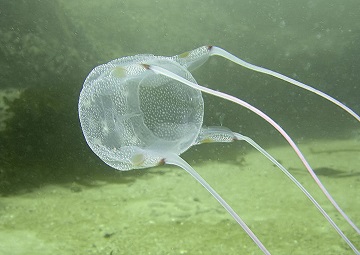The box jellyfish doesn’t look very threatening. Its delicate cube-shaped “bell” measures only a few inches per side, while its tentacles look like long strands of spaghetti. Yet in some species of box jellyfish, those strands contain some of the deadliest venom on the planet — powerful enough to kill an adult in minutes.
Box jellyfish are found in warm waters across parts of the Pacific and Indian oceans. They’re especially well known in Australia’s Great Barrier Reef.
 A box jellyfish. Credit: Peter Southwood. Creative Commons Attribution-Share Alike 3.0 Unported license
A box jellyfish. Credit: Peter Southwood. Creative Commons Attribution-Share Alike 3.0 Unported licenseThey’re among the most interesting of all jellyfish — and not just because of their fatal attractions. While most jellies float with the currents, box jellyfish propel themselves through the water, topping out at speeds of five miles per hour. And they have clusters of eyes on each side, including complex eyes that help them see prey and avoid obstacles.
But they’re best known for their sting. A box jellyfish has up to 15 tentacles extending from each corner of the “box,” and each tentacle is lined with thousands of stinging cells. The cells stick to prey or predators, and in a fraction of a second they inject a nasty toxin. It paralyzes prey almost instantly. In humans, it attacks the heart and nervous system and damages the skin, often leaving long, deep scars. The stings are extremely painful as well. Most victims survive, but fatalities are recorded each year.
About the only creatures that don’t have to worry about box jellies are sea turtles. They’re not bothered by the venom, so a box jellyfish becomes a tasty “box” lunch.

